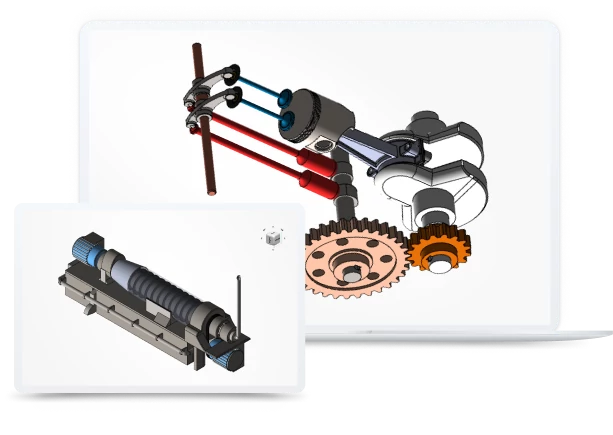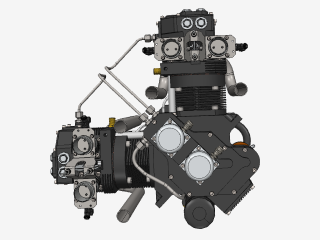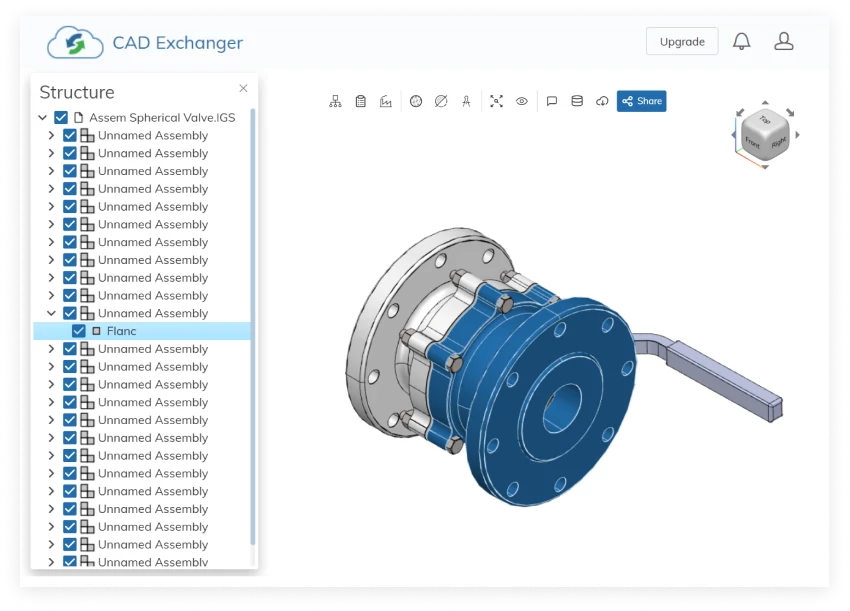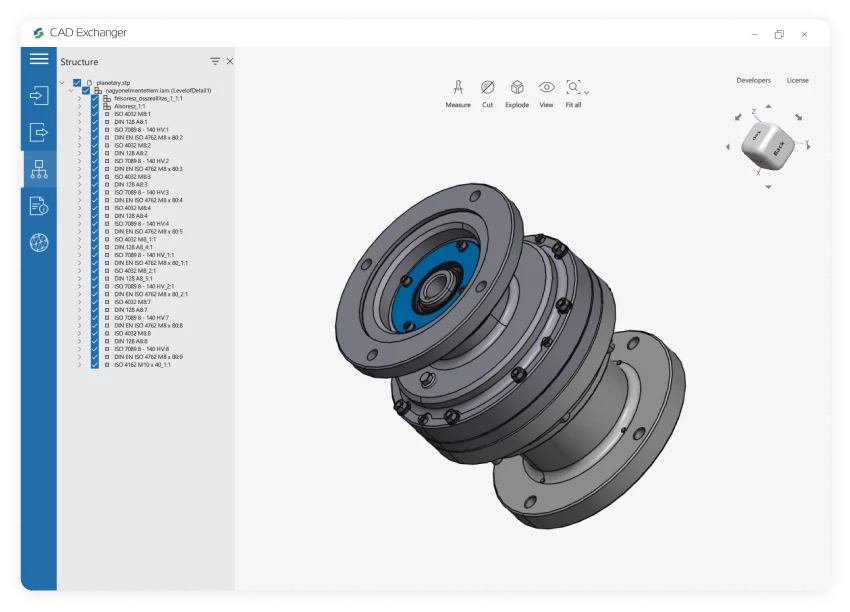

Conversion from FBX to Siemens NX is not supported yet :(
Learn more
FBX
The FBX format, also known as FilmBox, is a flexible file format that finds extensive use in the entertainment industry for storing 3D models, animations, and associated digital assets. Created by Autodesk, it is commonly employed in video games, movies, and VR applications. FBX files act as comprehensive repositories, preserving essential details such as 3D shapes, textures, animations, and more.
Support of FBX in CAD Exchanger
CAD Exchanger can import any FBX files and export FBX files of version 7.2, 7.4, and 7.5 in Binary and ASCII format. Such support includes:
- polygonal representations;
- assembly structure;
- names;
- colors, materials, textures.
Follow this link to check out all the CAD Exchanger products.
Pros of the format
Versatility and Compatibility
One of the major advantages of this format is its versatility and compatibility. FBX files can be easily shared and utilized across various softwares, making it convenient for collaboration between designers and game developers. FBX guarantees effortless transfer and utilization of 3D models and animations across diverse software environments.
Comprehensive Data Storage
FBX files store a wide range of information related to 3D assets, providing a comprehensive solution for content creators. This format allows you to store geometry, textures, animations, lighting, materials, and more in a single file. This comprehensive data storage capability simplifies asset management, ensuring that all the necessary components are packaged together and can be easily accessed or modified as needed.
Cons of the format
Proprietary Format
One of the drawbacks of FBX is that it is a proprietary file format owned by Autodesk. This means that the specifications of the format are not publicly available, making it more challenging for third-party developers to create software that fully supports FBX. While Autodesk provides an SDK for FBX, the closed nature of the format can sometimes limit interoperability with certain software applications.
Large File Sizes
FBX files can sometimes be quite large, especially when they contain complex geometry, high-resolution textures, or numerous animations. This can pose challenges when it comes to file storage and transfer, particularly for projects with limited bandwidth or storage capacity. Files may require additional time and resources for processing, potentially impacting workflow efficiency.
FAQ
Is FBX format specification publicly available?
While the complete specification is not publicly available, Autodesk provides an SDK Programmer's Guide that allows developers to work with FBX files and access the necessary information.
What are .fbx file extensions?
This file format itself does not require any specific sub-extensions, as the ".fbx" extension alone is sufficient to identify the file as an FBX file.
How to open an .fbx file?
To open this file, you will need a compatible software application, for example, CAD Exchanger Lab. Launch the software and navigate to the 'New file' option. Browse your computer's directories and locate the .fbx file you want to open. Then select it and click "Open". Once the import process is complete, the .obj file should be loaded into the software, allowing you to view and interact with the 3D model and associated data.
History of FBX format
FBX was initially developed by Kaydara, a Canadian software company, in the late 1990s. The purpose behind creating FBX was to provide a universal file format that could facilitate the exchange of 3D content.
In 2006, Autodesk, a leading software company, acquired Kaydara and took ownership of this format. Autodesk continued to develop and enhance this format, expanding its capabilities and compatibility with their various software applications such as Autodesk Maya and MotionBuilder. With Autodesk's support and resources, FBX gained even more traction and became widely adopted in the industry.
Throughout its evolution, FBX has expanded its capabilities to encompass an extensive array of features. These include geometry, textures, animations, cameras, lights, materials, and more. As a result, it has emerged as a widely accepted format for exchanging 3D assets, not just within Autodesk software, but also across diverse software applications from different vendors.
Siemens NX
Siemens NX is a proprietary format developed by Siemens Digital Industries Software and is optimized for seamless interoperability and efficient data exchange within the NX ecosystem. This format enables users to preserve the integrity and accuracy of their designs while facilitating collaboration and facilitating various engineering processes throughout the product lifecycle.
Support of Siemens NX files in CAD Exchanger
CAD Exchanger can import .prt files from v5 to 2212. Such support includes:
- B-Rep representations;
- polygonal representations (including multi-LODs);
- assembly structure (via external files);
- names;
- graphical PMI;
- colors.
Follow this link to check out all the CAD Exchanger products.
Pros of the format
Synchronous Technology
It is a capability integrated into the Siemens NX format that provides significant advantages for engineers and designers, including flexible editing, faster design iterations, easy collaboration, and enhanced design reuse.
Synchronous Technology allows for direct editing of geometry without being constrained by the traditional parametric modeling approach. Designers can easily modify and manipulate geometry without the need to track and update a complex history tree. Moreover, changes can be made directly on the model, providing instant feedback and allowing for quicker design optimization.
Integrated Product Lifecycle Management
One of the key advantages of the Siemens NX format is its seamless integration with Teamcenter PLM solutions. This integration allows for comprehensive product data management, including design, simulation, manufacturing, and collaboration, all within a unified environment. The tight integration of PLM capabilities ensures data consistency, reduces errors, and improves collaboration throughout the entire product lifecycle.
Cons of the format
Proprietary nature
Because the NX file format is specific to Siemens NX, developers may encounter challenges when trying to exchange data or collaborate with users or systems that utilize different file formats. This can require additional conversion or translation steps, which may introduce complexity and potential data loss or inconsistencies.
Furthermore, working with a proprietary file format restricts developers from leveraging open-source or third-party libraries and tools that are not designed to work directly with the NX format. This limits the flexibility and extensibility of developers' applications and may require more effort to implement certain functionalities.
Cost
The Siemens NX format refers to high-end CAD software, and it comes with a corresponding price tag. Compared to some other CAD tools, the licensing and maintenance costs for NX can be relatively higher. This may make it less accessible for individual users or small businesses with limited budgets. However, it's worth noting that the comprehensive features and robust capabilities of NX often justify the investment for larger organizations or industries where its unique strengths are crucial.
FAQ
What industries is the Siemens NX format commonly used in?
The Siemens NX format is widely used in industries such as automotive, aerospace, machinery, and many more. It caters to the needs of professionals involved in product design, manufacturing, and simulation.
Can the Siemens NX format be used for 2D drafting?
Yes, the Siemens NX format supports both 2D and 3D drafting and modeling. It offers a comprehensive set of tools for creating and editing 2D drawings, as well as designing complex 3D models.
Does CAD Exchanger have any limitations related to the Siemens NX format?
Yes. Siemens NX assemblies are represented with external files and it's possible for an assembly to contain components saved by different versions of NX. In case some of the components are saved by an unsupported version of NX, CAD Exchanger will not be able to load them and they will be omitted from the imported product structure.
How to open a .prt file?
To open this file, you will need a compatible software application, for example, CAD Exchanger Lab. Launch the software and navigate to the 'New file' option. Browse your computer's directories and locate the .prt file you want to open. Then select it and click "Open". Once the import process is complete, the .prt file should be loaded into the software, allowing you to view and interact with the 3D model and associated data.
History of Siemens NX format
The NX format has an interesting history that traces back to the early 1990s. It was initially developed by Unigraphics Solutions, a company founded in 1969 and later acquired by Siemens AG in 2007. Unigraphics, which later became known as Siemens Digital Industries, introduced the first version of the NX software suite in 1996.
Over the years, NX has evolved into a comprehensive and powerful CAD and CAM solution. With each new release, NX has consistently pushed the boundaries of innovation and set new industry standards. It has become a perfect choice for professionals in various industries, including automotive, aerospace, and industrial machinery.
The NX format itself has been constantly refined and enhanced to support advanced modeling techniques, simulation capabilities, and data management. It offers a range of features, such as parametric modeling, assembly design, digital simulation, and more, allowing engineers and designers to create and optimize complex products with efficiency and precision.
Today, the Siemens NX format is recognized as a leading CAD format, known for its robustness, flexibility, and compatibility with other industry-standard formats. It continues to evolve and adapt to the ever-changing needs of the engineering and design community, empowering users’ capabilities.
From Our Blog

Everything you need to know about CAD file formats
A CAD file is an output of a CAD software, containing key information about the designed object: its geometry and topology representation, 3D model hierarchy, metadata, and visual attributes depending on the format of the file.
Read more
Integration with UNIGINE engine
This article explores the integration possibilities with the UNIGINE engine, a powerhouse in the realm of virtual simulation and game development. Learn how it can be used in applications built with the UNIGINE engine to import CAD and 3D models.
Read more
Manufacturing Toolkit and Web Toolkit enhancements, Unity performance optimization, renaming and rotating SDK examples in release 3.24.0
Explore the wall thickness at a specific point on a surface, enjoy four times faster Unity objects performance, and check out renaming and rotating examples in SDK.
Read more
